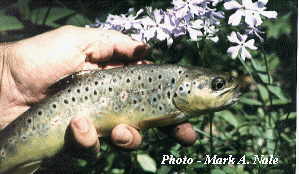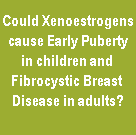How to avoid the cause of fibrocystic breast disease
Fibrocystic breast disease is caused by estrogen dominance. Synthetic chemicals in our environment mimic estrogens that encourage fibrocystic breast disease.
by Elizabeth Smith, M.D.
The cause of fibrocystic breast disease according to Dr. Lee, a Norwegian, is estrogen dominance. What does this mean? It means that
 women are getting too much estrogen.
women are getting too much estrogen. The Pharmaceutical Companies also believe that estrogen is the cause of Fibrocystic Breast Disease as they have previously tried to market a synthetic anti-estrogen androgenic steroid for fibrocystic breast disease.
Estrogen, in general, tells your body cells to proliferate. Progesterone tells your body cells to slow down. Progesterone says that your cells should mature and NOT reproduce. So where does this estrogen come from?
New research that has come to light during the past 5 - 10 years has shown that synthetic chemicals can mimic estrogen.
Chemical Foreign Estrogens (Xenoestrogens)
Around the world, there are approximately 100,000 different synthetic chemicals on the market. Some
 of
them mimic estrogen in the human body. One
classic estrogen mimic is DDT. In 1950, two Syracuse
University biologists, in an experiment, gave injections of DDT to baby roosters. The roosters grew up looking
like hens. Unfortunately, the U.S. still produces 96 tons of DDT a year (in 1991) and exports it to third world
countries. Then we consume DDT on imported produce. DDT is stored in the fat, notably the breast fat. The
breast fat may concentrate a form of DDT up to 700 times
than that of the blood. Blood levels of a form of DDT can typically be measured in the blood at several parts to
tens of parts per billion.
of
them mimic estrogen in the human body. One
classic estrogen mimic is DDT. In 1950, two Syracuse
University biologists, in an experiment, gave injections of DDT to baby roosters. The roosters grew up looking
like hens. Unfortunately, the U.S. still produces 96 tons of DDT a year (in 1991) and exports it to third world
countries. Then we consume DDT on imported produce. DDT is stored in the fat, notably the breast fat. The
breast fat may concentrate a form of DDT up to 700 times
than that of the blood. Blood levels of a form of DDT can typically be measured in the blood at several parts to
tens of parts per billion.When I first saw levels of parts per billion, I thought it was too low to worry about. Unfortunately, our human body operates on tens of parts per trillion. In other words, some of these chemical estrogens may be found routinely at levels one hundred times the concentration of our own hormones.
Imagine a baseball glove representing a receptor for estrogen. Think of the glove waiting to catch a ball. DDT is represented by one hundred shiny plastic balls. One watermelon representing your human estradiol. Which one does the glove catch?
More Chemical Foreign Estrogens ( Xenoestrogens)
New research by Soto, M.D. at Tufts University medical school in 1991 showed that chemical additives that make plastics last longer have estrogen stimulating effects on breast cancer cells in the test tube at parts per billion. Plastic test tubes with a new plastisizer stimulated breast cancer cells to grow wildly. Stanford University professors found a similar effect from an additive, bis-phenol A, used in polycarbonate water bottles. Bis-phenol A is also used in dental filling composites. Spanish researchers even found that some of the varnish sprayed in food cans (to prevent the "metal" taste) leached into the food. This slightly tainted food contained more than enough estrogen mimicking chemical to stimulate breast cancer cells in the test tube to grow rapidly. The above chemicals with estrogen mimicking effects are a class of chemicals known as alkylphenols.
English researchers studied a
 profusion of hermaphrodite trout in the English rivers. They found that the sewage
effluent draining into the river contained detergent breakdown products that stimulated estrogen receptors creating the hermaphrodite trout. Female
trout were found in the rivers. No male trout were found - only trout halfway between male and female.
profusion of hermaphrodite trout in the English rivers. They found that the sewage
effluent draining into the river contained detergent breakdown products that stimulated estrogen receptors creating the hermaphrodite trout. Female
trout were found in the rivers. No male trout were found - only trout halfway between male and female.Some alligator populations are having trouble reproducing because the male penises are too small (blush!). The female alligator ovaries had used up all their eggs prematurely ("burned out"). Researchers have implicated chemical hormone disrupters.
Agricultural Foreign Estrogens
Agriculture typically uses artificial estrogen compounds to fatten up cattle and chicken quickly. Estrogen also stimulates the retention of water giving a heavier weight and tender meat. Some proponents say that the artificial estrogen compounds disappear from the urine in a matter of days and the animals are then free of artificial hormones. Other opponents say the artificial estrogens are stored in the fat and then eaten by consumers.
In 1970's and 1980's, an epidemic of early puberty girls as young as a year old in Puerto Rico began menstruating after eating meat and dairy products with high amounts of estrogens. Some young boys developed breasts.
Women are now beginning to menstruate in the United States at age 10. The age of menarche used to be 16. Authorities have insisted that this is normal for a population with good nutrition. Is it?
15% Girls aged 8 sprouting pubic hair and breast buds?
Women are now beginning to menstruate in the
United States at age 10. The age of menarche used to be 16. Authorities have insisted that this is normal for a
population with good nutrition. Is it? Herman-Giddons in a landmark study done in 1997 published in Pediatrics
showed that out of 17,000 girls, 15% aged 8 years old began to show signs of puberty in the United States. See
the Time
Magazine article! The Time Magazine
article points a finger at chemicals in our environment that mimic estrogen.
Chemical Phobia?
One
study showed that elevated levels
of DDT and PCB were not markedly higher in women that had breast cancer. An editorial
confidently labeled the new concerns as chemical phobia. However, these are only two chemicals. We don't know much
about chemical interactions nor all the other chemicals which are as yet untested.
The Bottom Line
In the last 5-10 years, new research
has shown that certain chemicals in modern society do mimic estrogen in the test tube. These chemicals can come
from sources that we previously thought were inert such as plastics that might be used to package food and detergents.
Some animals
in the environment also show evidence
of hormone
disruption.
Presently, we do not know what these test tube studies mean for us. Human bodies can act differently. Unfortunately,
only a small fraction of chemicals have been tested for estrogen mimicking effects, and these chemicals are active
at infinitesimal small quantities way below what was previously thought to affect humans. Estrogen mimicking chemicals
can also act synergistically to amplify each other or even block each other. This is widely known, but exact synergistic
reactions and levels at which they occur are virtually unknown.
Chemicals in our environment having estrogenic effects known as xenoestrogens are now being investigated by the Environmental Protection
Agency.

